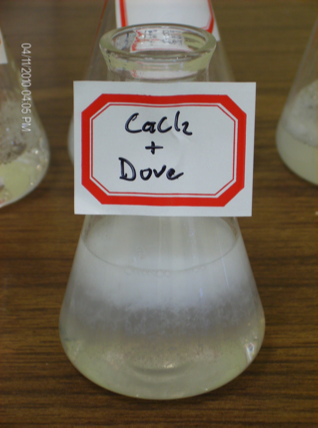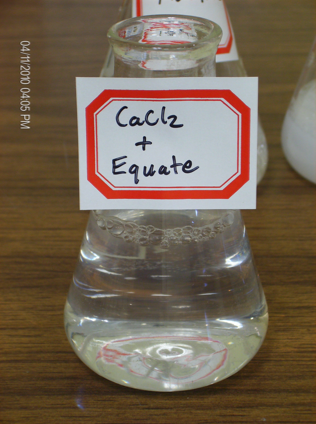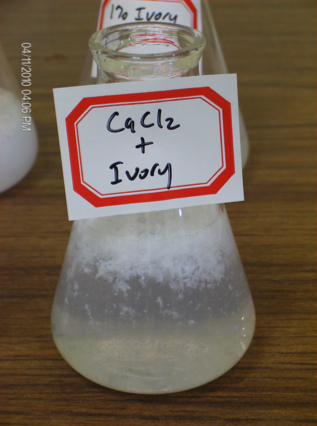If you haven’t seen the commercial, you can watch it below: (you can also view it on Dove’s website)
[flv:http://msbrandent.vo.llnwd.net/d1/msnbeet_doveus/flv/thedifference/scum_demo2.flv 576 324]
First, I’d like to say that I don’t think Dove is a terrible awful product and you should never use it. I think our soap is far better, but don’t take my word for it! All I’m trying to do is point out where Dove is misleading or not being completely honest. I won’t make any claims that I can’t back up.
Now, onto the ad. For this post I’m going to be heavily referencing a lecture given by Dr. Kevin Dunn. Kevin has a PhD in chemistry and has been studying soap specifically for many years. He’s already done the legwork here so instead of re-inventing the wheel I’m going to walk you through what he’s done.
The Dove ad makes a lot of claims. I’m interested in four of them
- 10 seconds into the video: “Soap scum is the combination of soap materials in a normal cleansing bar with the calcium ions that come from hard water”.
- 26 seconds into the video: “The cleansing system in a Dove bar is fundamentally different from soap.”
- 32 seconds into the video: “It [Dove] also does not interact with calcium in the way that a soap would.”
- 37 seconds into the video: “Soap leaves scum, and Dove doesn’t.”
Ok first things first. Claim #1:
“Soap scum is the combination of soap materials in a normal cleansing bar with the calcium ions that come from hard water”.
To test this out, Kevin ran a quick experiment using calcium chloride and distilled water (he essentially made hard water). He then took two separate samples of this and mixed Ivory (a soap) into one, and Equate (a detergent) into another. Here is the result:
You can see that the soap did in fact form a white substance when mixed with the hard water, while the detergent did not. So far so good.
VERDICT: Claim #1 is true.
Claim #2:
“The cleansing system in a Dove bar is fundamentally different from soap.”
First let’s figure out what’s actually in Dove. Might as well list out Ivory and Equate for comparison. Again, thanks to Dr. Dunn for breaking these down.
Ivory:
- Soap: sodium tallowate and/or sodium palmate,sodium cocoate and/or sodium palm kernelate
- Fatty acids: coconut acid, palm kernel acid, tallow acid, palm acid
- Other: water, glycerin, sodium chloride (salt), fragrance, tetra- sodium edta
Equate:
- Detergent: sodium laureth sulfate, sodium lauryl sulfate, co-camidopropyl betaine
- Other: Water, sodium chloride, fragrance, citric acid,…(11more minor ingredients)
Dove:
- Detergent: sodium lauroyl isethionate, sodium isethionate, co-camidopropyl betaine, sodium C14-C16 olefin sulfonate
- Soap: sodium tallowate, sodium palmitate, sodium stearate, sodium cocoate, sodium palm kernelate
- Fatty Acids: stearic acid, lauric acid
- Other: sodium EDTA and tetrasodium etidronate, water, sodium chloride, titanium dioxide, and maltol
Uh Oh. Dove actually contains soap! So how is it fundamentally different from soap? This is a pretty misleading claim. I’ll demonstrate next how dove and soap are not that different with respect to hard water.
VERDICT: Claim #2 is at best misleading, and at worst actually false.
Claim #3:
“It [Dove] also does not interact with calcium in the way that a soap would.”
Alright, let’s see what happens when we mix the same amount of Dove into the same solution of hard water:

Hmmmmm, that looks an awful lot like soap scum. That’s because it is. Anything that has soap in it will interact with calcium and form “soap scum”. The soap in Dove interacts with the calcium in hard water, the detergent in Dove does not. Notice that the chunks in here are a little smaller than with the Ivory. So technically their claim is accurate. Dove does not interact with calcium in the same exact way as soap. It’s a terribly misleading claim though, because they are implying that Dove doesn’t interact with calcium at all, or that it’s drastically different. In reality it’s nearly the same interaction: it produced soap scum!
VERDICT: Claim #3 is absolutely misleading.
Claim #4:
“Soap leaves scum, Dove doesn’t”
We’ve already established that Dove creates scum, but does it leave that scum behind on your skin? Does regular soap leave that scum behind on your skin? Dove attempted to answer this by testing how each one rinsed from a mirror.
Let’s take a look at the “experiment” used in the ad. There are a few things that are rather unscientific about it, namely:
- The person conducting the study knows which is Dove and which is soap.
- Dove is less soluble in water than soap, so the soap is going to be softer after soaking in water. This means it’s likely to leave a thicker film on the mirror than the Dove.
- Judging which one washed away faster or more completely is subjective.
- Your skin is not a mirror. Demonstrating the way soap and Dove rinse off a mirror doesn’t really give any valuable insight into how these things rinse off of skin.
Dr. Dunn actually improved upon this test by using a double-blind method, using a specific pattern on the mirror to reduce subjectivity, using uniform sample sizes of the different soaps tested, and running the experiment four times with four different groups of people. While his conclusions showed that Dove and Soap require a similar amount of effort to rinse, the test was still pretty subjective, and it still didn’t address how well Dove and Soap rinse from a person’s skin.
So, Dr. Dunn came up with an even better experiment. It’s a pretty neat test, and it’s something you can try out yourself, too!
Soap is a surfactant. This means it lowers the surface tension of lots of liquids. The one we’re interested in is water. Take a bowl of water and sprinkle pepper evenly over the surface. Now just touch the surface of the water (make sure your hands are completely clean and dry). As you’d expect, nothing happens. Now dry your finger off and swipe your finger across a dry bar of soap. You now have an invisible amount of soap on your skin. Touch the water again, and you’ll see the pepper fly out to the edges of the bowl. This is the visible result of the surfactant nature of soap.
What Dr. Dunn did was take four groups of people and test four different kinds of cleansers: A handmade soap (his own blend he calls “Delight”), Dial, Dove, and Ivory. He then conducted a double-blind study using the method above (well, almost, he used a person’s knuckle instead of the finger, to eliminate the chance of soap getting stuck under the fingernail and not rinsing easily).
First he tested whether this method was able to detect invisible amounts of soap on your skin. Each of the four groups were able to detect invisible amounts of soap on the skin using this method.
Next he ran the experiment again, this time rinsing the hand for 30 seconds under tap water before testing it on the pepper. The results are below. Remember this is a double-blind study, so no group is aware of which sample they are working with and judging.
- Delight: All four groups were unable to detect any soap remaining on the skin after rinsing.
- Dial: All four groups were unable to detect any soap remaining on the skin after rinsing.
- Dove: Groups 2, 3, & 4 were unable to detect any soap remaining on the skin, but group 1 did observe that there was some soap left on the skin.
- Ivory: All four groups were unable to detect any soap remaining on the skin after rinsing.
At last, Dr. Dunn conducted the experiment again, this time rinsing the hand for 30 seconds under hard water before testing it on the pepper. The results are below:
- Delight: All four groups were unable to detect any soap remaining on the skin after rinsing.
- Dial: All four groups were unable to detect any soap remaining on the skin after rinsing.
- Dove: Groups 1, 2, & 3 were unable to detect any soap remaining on the skin, but group 4 did observe that there was some soap left on the skin.
- Ivory: All four groups were unable to detect any soap remaining on the skin after rinsing.
So, does soap leave scum on your skin? The answer is no. However the results do bring some question as to whether Dove rinses cleanly all the time. It’s not enough to just claim that Dove does not rinse cleanly, though it does make one curious.
Some of you might be wondering “aren’t you just testing for soap, not soap scum?” It’s a valid question. The answers is this test does detect soap scum, too. Soap scum actually contains soap, (it also technically is a type of calcium soap) so it will have the same surfactant effect on the peppered water as plain soap.
Let’s just recap this experiment in contrast with Dove’s:
- The person judging the experiment is unaware of what they’re judging.
- Dove is still less water soluble than most soap, but we’re not soaking the bars first, so this should make for a more even comparison.
- The pepper test is much less subjective. The reaction is highly visible and drastic. It either detects soap & soap scum or it doesn’t. There’s not really any in-between.
- This test determines the rinsing ability on actual skin, not a mirror.
VERDICT: Claim #4 is totally false!
Many thanks to Dr. Kevin Dunn for all of his hard work on this and many other projects in the field of soap-making. He’s answered a lot of questions in this field that no one else has tackled. Here are the lecture notes I’ve used for this article. If you are interested in soap-making I highly recommend his book “Scientific Soapmaking”, which can be found over here.
Dove is a registered trademark of Unilever NV/PLC. Other brands are registered trademarks of their respective owners.
So, what do you think? Let me know in the comments section below!
H.M.


i’m doing a science project to prove if the claim on the dove commercial that dove leaves little to no soap scum…my biggest problem is finding books (i’m redoing the the dove experiement but on a smaller and cheaper scale).
I’d have to see more about the pepper protocol. If all you did was transfer some lime soap on a finger, it would not dissolve in the pepper-water, so it, as opposed to soluble soaps, would not be detected.
If, however, Dove is to sustain its claim that the stearic acid in it is a skin conditioner, then IT must be left on skin. It may be that fatty acid plates out more smoothly than lime soap, so there may be an advantage there, but I don’t know if there’s any evidence on that. I do notice that soap substitute cakes with paraffin or stearic acid binders do plate out that binder on the tile and tub below the soap dish, although stearic acid seems to have less of that effect than paraffin — although it’s said that stearic acid is better than paraffin for coating metals as a corrosion inhibitor. (This is done for fireworks that have mixtures of iron and potassium nitrate.) Dextrine bound soap substitutes don’t seem to have this problem, but they feel sticky and scratchy in use.
One definite difference in use of Dove and similar soap substitutes is that in water of even slight “hardness”, they don’t de-foam bubble baths, while soap does. Whether that’s an advantage or disadvantage depends on whether you’re looking to preserve the bubbles while washing, or to get rid of the bubbles to drain the tub.
As you can see from my Web link, I have some expertise on these matters. I’m also now the chief scientist of the Natural Clinical Trials Network, so if you’d like to have a product tested clinically, please ask me.
Robert,
You may wish to distinguish between lime soap and lye soap in your post, as it confused me the first time I read your note. I suspect you meant the latter in a few uses. Traditional lye soap (NaOH-derived soap) is what was used in the pepper test, and it certainly would leave some residue from the finger swipe technique, even if difficult to see. You can ‘feel’ it because of the glide it will allow when rubbing fingertips together prior to touching the water surface.
Lime soap, from what little I recall of my own chemistry classes, is the calcium salts (the insoluble ‘lime’ or ‘scum’ after the sodium fatty acid salts react with the hard water. Is that what you meant? I didn’t see a test with the dried calcium fatty acid salts in the pepper test, ‘though I agree with you because of their very low aqueous solubility, they may not yield a dramatic pepper surface tension effect.
My qualifications: I get to carry boxes, push the broom and man our farmers market stall for my wife’s company. That means I get a lot of questions from our buying public, and the more I can (gently) educate them accurately, the better off we all are.
just watched commercial on dove soap which “does not crack” like other soaps because it is have 1/4 moisture cream in it.
what a bunch of crap. I didn’t bother reading all the chemical properties of Dove, all I am concerned about is that they are lying.
Their soap cracks and turns black in the crack worse than any other soap I have used.
The only soap I’ve used that does not crack is soap made by home industries.
I had been a long-time user of Dove soap; my family was as well. Then, I recently discovered that the stuff is made from sodium tallowate (usually derived from cattle fat). Actually, if you read the ingredients label, it could be sodium tallowate or sodium palmate; you have no way of knowing which. It really amazed me that, in the 21st century, soap is not being made with non-animal derived substances. Call me crazy, but I just would rather not wash my face with beef fat. The ethical dimension is also a factor in my revulsion. I e-mailed Unilever (Dove’s manufacturer) and told them that I have stopped buying Dove soap, and advised my family and friends to do so as well. I figure this is fair, as it gives Unilever an opportunity to alter their business practices and switch to vegetable-based compounds from which to make their soap.
Now, I use vegetable-based soaps like Tom’s of Maine and olive-oil based soaps, and am very happy with the results.
I have one thing to say – sodium tallowate. yuk.
Thanks for taking the time to post this. I found it really interesting. As a former professional house cleaner I can testify that people who used Dove always had the MOST soap scum in their showers and sinks. Yuck!
Sue,
Yeah, I didn’t even address the ingredients list in a Dove bar. It makes you think twice about using it, that’s for sure. Glad our products work so well with your skin!
H.M.
Pretty scary stuff in a Dove bar (and other commercial bars as well). This puts us right back to homemade soap, of which Alabu bars rate right on top of my list. Every time I wash with soap (read detergent) in places such as a public restroom, my hands dry right out. With homemade soap (read Alabu) this does not happen.
Phil,
Yeah I’m kind of into it. What can I say? lol
H.M.
You like your job way to much. lol. pretty cool though.